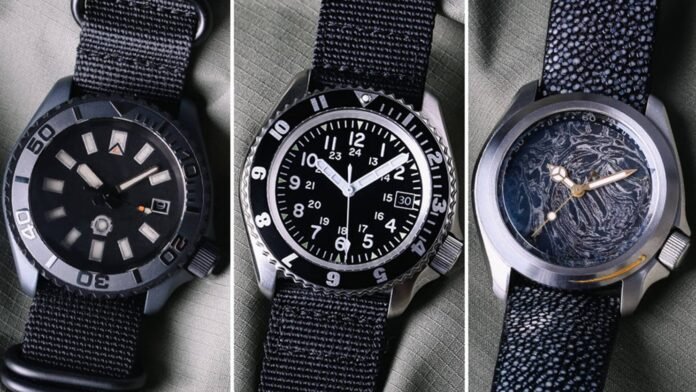Table of Contents
Choosing the Right Seiko Model
Researching Seiko Models
When embarking on your Seiko modding journey, the first step is to choose the right base model for your project. Seiko offers a wide range of watches that are popular for modding due to their affordability, availability, and compatibility with aftermarket parts.
- SKX007/009: Diver’s watch, iconic and highly moddable
- SNK800 series: Affordable and versatile
- SARB033/035: Dress watch with higher-end feel
Each model comes with its own set of features and potential for customization. It’s important to consider what style of watch you prefer, the level of modding you’re comfortable with, and your budget.
Remember, the goal is to create a best quality seiko mods timepiece that reflects your personal style while maintaining the integrity and functionality of the Seiko brand.
Understanding Seiko Movement Types
Seiko is renowned for its diverse range of watch movements, each offering unique features and benefits. Understanding the different movement types is crucial for selecting the right components for your DIY mod project. Seiko’s movements can be broadly categorized into three types: mechanical, quartz, and Spring Drive.
- Mechanical: These movements are powered by a mainspring and regulated by a balance wheel. They are appreciated for their craftsmanship and the smooth sweep of the second hand.
- Quartz: Known for their accuracy and low maintenance, quartz movements are battery-powered and use a crystal oscillator for timekeeping.
- Spring Drive: A hybrid of mechanical and quartz, the Spring Drive offers the beauty of a mechanical movement with the precision of quartz.
Each movement type will influence the modding process differently, from the selection of tools to the types of parts you can use. It’s important to choose a movement that aligns with your modding goals and skill level.
Remember that compatibility is key. Not all mod parts will fit every movement, so ensure you have the right specifications before purchasing components.
Identifying Compatible Mod Parts
Once you have a clear understanding of the Seiko model and movement type you’re working with, the next step is to identify compatible mod parts. Compatibility is key to ensuring that the modifications you plan will fit and function correctly with your Seiko watch. Here’s a list of common mod parts and their compatibility considerations:
- Dials: Must match the movement and dial feet positions.
- Hands: Need to be the correct size and style for the movement.
- Bezel Inserts: Should be designed for the specific case shape and size.
- Crystals: Require precise measurements to fit the case.
- Straps and Bracelets: Must have the correct lug width and length.
When selecting parts, also consider the aesthetic coherence of your design. A mismatched dial and hand style can detract from the overall look of your custom Seiko.
It’s advisable to source parts from reputable suppliers who provide detailed specifications and compatibility information. This can save you from the frustration of receiving parts that don’t fit or aren’t up to your quality standards. Remember, the goal is to create a timepiece that is both uniquely yours and maintains the integrity of its function.
Essential Tools and Supplies
Watch Repair Kit
A comprehensive watch repair kit is the cornerstone of any successful Seiko modding project. Having the right tools at your disposal is crucial for a smooth and safe customization process. These kits typically include a variety of tools tailored for watch disassembly, repair, and reassembly.
- Screwdrivers: For removing case backs and bracelet links.
- Tweezers: Essential for handling small parts like screws and springs.
- Case opener: To safely open the watch case without damage.
- Loupe: For magnified inspection of watch components.
It’s important to choose a kit that includes tools made from quality materials to avoid damaging your watch. Investing in a kit with a wide range of tools will pay off in the long run, as it will be useful for various types of watch modifications and repairs.
Spring Bar Tool
A spring bar tool is essential for safely removing and attaching the watch strap or bracelet to your Seiko watch. This tool is designed to compress the spring bars that hold the strap in place without damaging the watch’s lugs or the strap itself.
- Look for a spring bar tool with a fine forked tip for easier manipulation of the spring bars.
- Ensure the tool has a sturdy handle for a secure grip during use.
- Some spring bar tools come with a reversible or interchangeable tip that includes a push-pin on the opposite end, which can be useful for watches with drilled lugs.
When using the spring bar tool, apply gentle pressure and work slowly to avoid slipping and potentially scratching your watch. Patience is key in this delicate operation.
Mod Parts and Accessories
Once you have your tools at the ready, the next step is to select the mod parts and accessories that will define the look and functionality of your customized Seiko watch. Choosing the right components is crucial, as they must not only fit your Seiko model but also match your personal style and the aesthetic you aim to achieve.
- Dials: Available in various colors and designs.
- Hands: Choose from different shapes and luminosity.
- Bezel Inserts: Options include ceramic, aluminum, and sapphire.
- Crystals: Sapphire crystals are popular for their scratch resistance.
- Straps and Bracelets: Leather, NATO, rubber, or metal.
When selecting parts, consider the harmony between them. A cohesive design is often more appealing than a mix of mismatched elements.
Remember, the quality of the parts you choose will directly impact the overall look and feel of your watch. It’s worth investing in high-quality components that will stand the test of time and wear.
Preparation and Disassembly
Setting Up Your Workspace
Before you begin the intricate process of modding your Seiko watch, it’s crucial to set up a clean, well-lit, and organized workspace. A clutter-free environment will not only facilitate ease of work but also prevent the loss of small watch components.
- Ensure your work surface is flat and stable.
- Cover the area with a soft mat or cloth to protect the watch parts and to prevent them from rolling away.
- Position adequate lighting to avoid any shadows that might hinder your precision work.
- Keep your tools and parts within easy reach but organized to avoid confusion.
Remember, the right environment can significantly enhance the efficiency and enjoyment of your modding experience.
Removing the Watch Case Back
Once you have your workspace set up and your tools at hand, the next step is to remove the watch case back. This is a delicate process that requires patience and a steady hand. Ensure you have the correct size of case back opener to avoid damaging the watch.
- Place the watch face down on a soft cloth to prevent scratching.
- Fit the case back opener into the notches of the case back.
- Apply even pressure and turn counterclockwise to open.
Remember, some Seiko models may have a screw-down case back, while others might feature a snap-off design. It’s crucial to know which type you’re working with to apply the correct method.
After the case back is removed, organize the parts carefully to avoid losing any small components. This will make reassembly much smoother.
Taking Apart the Seiko Watch
Once the case back of your Seiko watch is removed, you’ll be ready to disassemble the watch components. Carefully organize each part as you remove them to ensure a smooth reassembly process later on.
- Begin by removing the crown and stem.
- Next, take out the movement carefully, and place it on a soft surface.
- Proceed to detach the hands and dial, being mindful of the delicate pins and gears.
Remember, patience and a steady hand are crucial during this step to avoid damaging the intricate parts of the watch movement.
After all the parts are laid out, inspect them for any signs of wear or damage. This is the perfect time to clean or replace any components before you start the customization.
Customization Techniques
Changing the Dial and Hands
Changing the dial and hands of your Seiko watch can dramatically alter its appearance and give it a personalized touch. Selecting the right dial and hands that fit your Seiko model is crucial for a successful mod. Compatibility with your watch’s movement type is essential to ensure that the new components will fit and function correctly.
- First, source the dial and hands that match your aesthetic preferences and watch specifications.
- Next, carefully remove the old dial and hands using the appropriate tools from your watch repair kit.
- Then, align and secure the new dial, followed by the installation of the hands, ensuring they are set at the correct position for the movement.
Remember to handle the components with care to avoid damaging the delicate parts or leaving fingerprints on the inside of the crystal.
Once the new dial and hands are in place, it’s important to double-check their alignment and make sure they move smoothly. This customization not only refreshes the look of your watch but can also be a rewarding experience as you learn more about the intricacies of watchmaking.
Upgrading the Bezel Insert
The bezel insert is a defining feature of your Seiko watch, and upgrading it can dramatically change its appearance. Choosing the right bezel insert is crucial, as it should match both the style of the watch and your personal taste. There are various materials and designs to consider, from ceramic to aluminum, and from classic to contemporary looks.
When selecting a bezel insert, consider the following factors:
- Compatibility with your Seiko model
- Material durability
- Color and design preference
- Lume quality for visibility
Upgrading the bezel insert is not just about aesthetics; it’s also an opportunity to enhance the functionality of your timepiece. A high-quality insert with better lume can improve visibility in low light conditions.
Installation is straightforward but requires precision. Here are the steps:
- Remove the old bezel insert using a thin blade or bezel removal tool.
- Clean the bezel to remove any adhesive residue.
- Apply a thin layer of adhesive to the bezel.
- Carefully align and place the new insert onto the bezel.
- Press down firmly to ensure it is securely attached.
Remember to take your time and ensure proper alignment to avoid any gaps or misplacement. With patience and attention to detail, your Seiko will have a fresh, customized look.
Installing a New Watch Strap
Once you have chosen your new watch strap, installing it is a straightforward process that can significantly alter the look and feel of your Seiko watch. Ensure that the strap width matches the lug width of your watch to avoid any gaps or overhang.
- Measure the lug width of your Seiko watch.
- Select a strap that matches the width and complements the style of your watch.
- Use the spring bar tool to remove the old strap.
- Position the new strap and secure it with the spring bars.
Remember to handle the spring bars carefully to avoid losing them during the strap change. A lost spring bar can be frustrating and may delay your modding project.
After the new strap is installed, give your wrist a feel for the new fit. Adjust the strap as necessary to ensure comfort and to accommodate any wrist size changes throughout the day.
Final Assembly and Testing
Reassembling the Seiko Watch
Once all the custom parts are in place, the delicate process of reassembly begins. It’s crucial to ensure that each component fits back into its original position with precision. Start by securing the movement and then carefully aligning and placing the dial and hands.
- Ensure the gaskets are clean and seated properly to maintain water resistance.
- Reattach the case back, using the correct notches and applying even pressure.
- Confirm that the crown and pushers (if any) are aligned and functioning smoothly.
During reassembly, take special care not to force any parts together. If a component does not fit easily, double-check its alignment and try again. Forcing parts can cause damage and affect the watch’s performance.
After the case is sealed, give the watch a gentle shake to ensure the rotor is moving freely, indicating that the automatic winding mechanism is operational. This step is a good indicator that the watch is well on its way to being fully functional once more.
Checking for Proper Functionality
Once your Seiko watch has been reassembled, it’s crucial to ensure that all functions are operating correctly. Check the timekeeping, date change, and any other complications your watch may have. This is to ensure that the modifications have not affected the watch’s core functionalities.
- Verify the timekeeping against an accurate clock or time standard.
- Observe the date change at midnight to confirm it’s functioning properly.
- Test any additional features like chronographs or alarms.
Remember, the goal is to have a watch that not only looks great but also performs flawlessly. If you encounter any issues, you may need to revisit the assembly process to identify and correct the problem.
Adjusting Timekeeping Accuracy
Once your Seiko watch is reassembled, it’s crucial to ensure that it keeps time accurately. Use a timegrapher or a similar tool to measure the watch’s accuracy. This device will help you understand how your modifications have affected the watch’s performance.
- Place the watch on the timegrapher.
- Observe the readings for beat error and rate.
- Make adjustments to the regulator if necessary.
Fine-tuning the timekeeping may require patience and multiple adjustments. Remember, even a small tweak can make a significant difference.
Consistent accuracy is the hallmark of a well-modified watch. Aim for a daily rate deviation within the range of +/- 10 seconds for a well-performing Seiko mod.
Conclusion
In conclusion, DIY Seiko mods offer a fun and creative way to personalize your timepiece. By following this beginner’s guide, you can learn the basics of customizing your watch and express your unique style. Remember to take your time, be patient, and enjoy the process of transforming your Seiko watch into a one-of-a-kind piece that reflects your personality and taste.
Frequently Asked Questions
Can I customize any Seiko model?
While many Seiko models are popular for customization, it’s important to research compatibility with mod parts before starting your project.
Do I need special tools for Seiko mods?
Yes, having the right tools like a watch repair kit and spring bar tool will make the customization process easier and more efficient.
Is it easy to change the dial and hands of a Seiko watch?
Changing the dial and hands requires precision and patience, but it can be done with the right tools and techniques.
How do I ensure the new mod parts fit my Seiko watch?
Before purchasing mod parts, make sure to identify the compatible models and sizes to ensure a proper fit.
Can I revert my Seiko watch to its original state after customization?
In most cases, you can reverse the modifications and restore your Seiko watch to its original condition if desired.
Will customizing my Seiko watch void the warranty?
Modifying your Seiko watch may void the manufacturer’s warranty, so it’s important to consider this before making any changes.






















